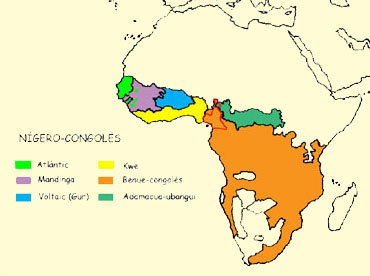
| Sociolingüística internacional |
| Plurilingual competence. A concrete example: Cameroon, by Mònica Molina | ||||
| CONTINUA |
The Atlas Linguistique du Cameroun (1963) mentions 247 national languages: Bantu-type in the southern part of the country; and Adamaua–Ubangui type in the north, although both belong to the same family (Niger–Kordofanian according to Greenberg’s classification, 1963) [see map]. (4) The Niger–Kordofanian family according to Greenberg’s classification (1963)
No national language is dominant over the others, and it is therefore unlikely that any one of them will be given official status. Thus, since the unification of the national territory in 1961, the Cameroonian government has adopted French and English as the official languages, present in the Civil Service, mass media and at school. The country’s language policy considers English-French bilingualism to be advantageous for its inhabitants, and civil service documents are drafted in both languages. However, the reality is that English is only used in 2 of the country’s 10 provinces (north-west and south-west), whilst French is the language of intercommunication par excellence for 75% of the population. At school, one of the two languages is chosen as the vehicular language from pre-school teaching and the other is introduced into teaching during primary education. None of the languages that we have termed national are taught at school, despite the fact that, since the 1970s, many public and private universities have conducted numerous studies contributing to the knowledge of these languages , and the Ministry of Education now recommends their introduction into the education system. (5) However, only in certain areas in the north of the country is a national language (Fulfulde) used as the vehicular language at primary school. In addition, a third language is introduced into teaching at secondary level. We shall term this foreign language, (6) referring to a third or fourth acquired language that is not of the learner’s medium. When Cameroon obtained her independence in 1960, she retained the option of Spanish and German as foreign languages during the first two courses of the baccalaureate course, in line with the educational system of the ex-coloniser, France. Hence, the country’s six university faculties currently have a Spanish or German Language Section in their Foreign Language Departments, and the Université de Yaoundé also offers the option of learning Catalan. The number of students of Spanish in 1991 in both secondary (85,000) and higher education (700), (7) is a very significant reflection of the interest in learning this language. So, how are these languages taught at school? In the case of Spanish, textbooks are mainly 1970s French manuals, and the contents, aims and learning assessments have scarcely changed since 1978. (8) Language teaching and learning at school is based mainly on the written language and focuses on learning grammatical structures. This means that assessments almost always consist of writing a composition such as the one that follows, written by a Cameroonian teacher as an example for his Spanish students:
|
